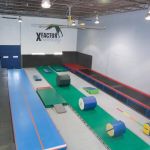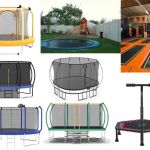- understanding-trampoline-price-ranges-in-2025
- key-factors-that-affect-trampoline-costs
- indoor-vs-outdoor-trampolines-price-differences
- budget-vs-premium-which-one-suits-you
- hidden-costs-assembly-accessories-and-warranty
- real-customer-story-finding-the-right-fit
- where-to-shop-smart-in-2025
1. Understanding Trampoline Price Ranges in 2025
In 2025, the cost of a trampoline in the US can vary significantly depending on size, style, brand, and included features. On average:
- Small indoor trampolines (for kids or fitness) start at around $70–$120.- Mid-sized backyard trampolines cost $200–$450.- Large or premium models (with safety enclosures, extra padding, or springless designs) can exceed $800–$1,500.
These ranges reflect standard pricing seen across popular retailers and online platforms. But what really drives the price? Let’s break it down.
2. Key Factors That Affect Trampoline Costs
When considering how much a trampoline costs in the US, it’s not just the size. Several factors influence the final price tag:
2.1 Size & Shape
Round trampolines are typically more affordable than rectangular ones. A 12-ft round version might be $300, while a similarly sized rectangular trampoline may go for $500+ due to its frame structure and bounce performance.
2.2 Frame and Material Quality
Galvanized steel frames with rust protection and UV-resistant mats last longer but add cost. Choosing a cheaper frame might save upfront but could lead to replacement sooner.
2.3 Brand and Warranty
Established brands like Skywalker, Springfree, or Zupapa charge more—but often offer extended warranties and proven safety features, which matter to parents.
3. Indoor vs Outdoor Trampolines: Price Differences
Indoor mini-trampolines are designed for fitness or toddlers and usually cost under $150. Outdoor trampolines, which are bigger and built for rougher use, start around $200 and can exceed $1,000.
For instance, a customer in Ohio recently purchased a foldable rebounder for $95, while her backyard 15-ft trampoline for three kids cost $479. Both had very different durability and usage expectations.
4. Budget vs Premium: Which One Suits You?
If you’re buying a trampoline for seasonal backyard fun, a mid-range model ($250–$450) will typically do the trick. But if you're serious about durability, year-round use, or have athletic teens, consider springless or professional-grade options starting from $800.
For example, one family from California invested in a $1,200 Springfree model after their $300 trampoline broke within two years. Their verdict? “Expensive, but worth it for the peace of mind.”
5. Hidden Costs: Assembly, Accessories, and Warranty
Don’t forget to factor in the extras:
- Assembly services: Can cost $100–$250 if you hire help.
- Ladders, weather covers, anchor kits: Add-ons that range from $20–$100 each.
- Extended warranties: Some brands charge extra for coverage beyond 1–2 years.
These hidden fees can push your total cost beyond the listed product price, especially if you’re aiming for longevity and safety.
6. Real Customer Story: Finding the Right Fit
In 2024, a dad in Denver named Mark shared his trampoline buying experience. He started with a cheap $150 trampoline from a clearance sale. “It lasted one summer, then the frame bent and the mat tore,” he said.
By 2025, Mark had learned his lesson. After researching extensively and reading reviews on Trampoline Zone, he picked a mid-tier 14-ft model with safety netting for $399. It’s now been through two winters—and still going strong.
7. Where to Shop Smart in 2025
Online platforms often offer better deals than local stores, especially when bundled with accessories. But not all websites offer verified quality and support. If you’re looking for trusted trampoline options with transparent pricing, Trampoline Zone provides a well-curated selection to suit all budgets.
From starter options for toddlers to professional-grade backyard setups, you can explore prices and compare features in one place before making a purchase decision that lasts.







 Happy jump Nashville5.0 (11 reviews)
Happy jump Nashville5.0 (11 reviews) Altitude Trampoline Park Phoenix4.0 (353 reviews)
Altitude Trampoline Park Phoenix4.0 (353 reviews) Dunham's Sports4.0 (81 reviews)
Dunham's Sports4.0 (81 reviews) Altitude Trampoline Park Spring-Klein4.0 (1498 reviews)
Altitude Trampoline Park Spring-Klein4.0 (1498 reviews) NorCal Jump4.0 (285 reviews)
NorCal Jump4.0 (285 reviews) X Factor Tumbling, Wyckoff NJ5.0 (60 reviews)
X Factor Tumbling, Wyckoff NJ5.0 (60 reviews) Are Trampoline Parks Safe for Kids? Essential Guide for U.S. Parents
Are Trampoline Parks Safe for Kids? Essential Guide for U.S. Parents How Often Should You Replace Trampoline Springs? Tips for Proper Maintenance
How Often Should You Replace Trampoline Springs? Tips for Proper Maintenance How Much Is a Trampoline? A Detailed Guide to Trampoline Costs and Buying Tips
How Much Is a Trampoline? A Detailed Guide to Trampoline Costs and Buying Tips Bounce Techniques for Stronger Legs: Effective Exercises and Tips
Bounce Techniques for Stronger Legs: Effective Exercises and Tips Essential Music Gear for Trampoline Dance: Complete Guide
Essential Music Gear for Trampoline Dance: Complete Guide Fun STEM Experiments Using Trampolines to Spark Curiosity and Learning
Fun STEM Experiments Using Trampolines to Spark Curiosity and Learning